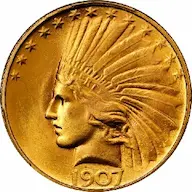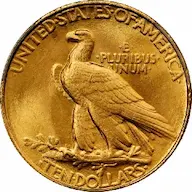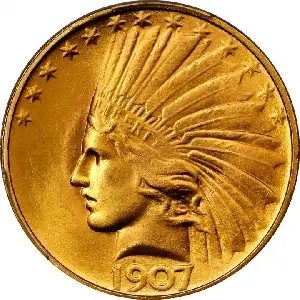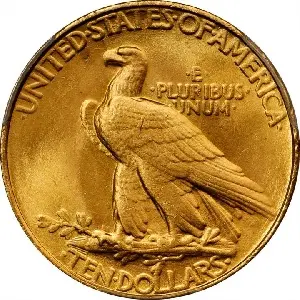1907 Indian Head $10 Eagle, Rolled Rim, Periods
The story of the 1907 Indian Head “Rolled Rim” $10 eagle closely tracks that of the 1907 “Wire Rim” eagle.
“If at first you don't succeed, try, try again.”
The origin of this famous saying is not known, but whoever coined it (pun intended) may have had the Indian Head $10 eagle in mind.
As we have learned, in 1905 President Theodore Roosevelt enlisted the skill of the great sculptor Augustus Saint-Gaudens to develop new designs for the nation’s gold $10 eagle and $20 double eagle.(1)
For the $10 eagle, Saint-Gaudens portrayed Miss Liberty adorned with an Indian war bonnet. The reverse is dominated by a proud eagle perched on a bundle of arrows. Periods were placed on before and after each word in E PLURIBUS UNUM, UNITED STATES OF AMERICA, and TEN DOLLARS. Collectors call this coin type the Indian Head eagle.
Try #1 to manufacture the Indian Head eagle ended in disappointment, because the thin “Wire Rim” edge of the Saint-Gaudens design prevented proper stacking. Furthermore, the coin's high relief was deemed certain to impede mass production.(2)
Before moving on, a dejected Roosevelt ordered “several hundred” of the Wire Rim, high relief version be struck, writing “They should be preserved as the work of a great American artist." A total of 500 examples were struck on a medal press.(3)
Mint Engraver Charles Barber spearheaded Try #2. He replaced the wire rim with a rolled rim feature, intended to improve stacking capability, but retained the periods. Dies were manufactured and a few trial pieces were struck.(4)
Just as the Mint was mobilizing to issue Try #2 (Rolled Rim) on a large scale, a second set of models was received from the Saint-Gaudens estate (the artist passed away on August 3, 1907). These models were characterized by lower relief and modified rims to promote easy stacking. Moreover, the periods that were placed on the original design on the reverse had been removed. Let’s call this Try #3.
Barber concluded the latest models from Saint-Gaudens (Try #3) would lead to a superior coin than his rolled rim modification (Try #2), and recommended hubs and dies be manufactured from these models. Due to a misunderstanding, Acting Mint Director Robert Preston ordered mass production of Barber’s rolled rim variety, commencing on September 13. The exact number struck is uncertain, but most numismatists believe it to be about 31,500.
When Frank Leach took control as Mint Director on November 1, he sided with officials who preferred the second set of Saint-Gaudens models (Try #3) for making the Indian Head eagle. The sharpness of detail, ease of mass production, and perfect stacking capability of Try #3 won the day.(5)
Leach ordered all 31,500 Rolled Rim (Try #2) pieces destroyed, sparing just 40-50 of them for posterity’s sake. These survivors went to museums and well-connected individuals.(6) Try #3 was at last a success, with 239,406 struck before year’s end.(7)
Both the "Wire Rim" and "Rolled Rim" (with periods) varieties of the 1907 Indian Head eagle are prized acquisitions, although the rolled rim coin is about ten times rarer than the wire rim. Thankfully, nearly all Leach's preserved representatives of the rolled version still exist today.(8)
In June 1946, legendary coin dealer Max Mehl wrote of the 1907 Rolled Rim (with periods) eagle: "Although this coin has a recent record of $375.00, I believe that this record is in its infancy."(9)
Mehl was quite the visionary. As one of the most treasured coins of the 20th century, prices for this beauty have risen higher and faster than most collectible coins.
| Estimated survivors in all grades: 41 ?
The survivor estimate from PCGS represents an average of one or more experts' opinions as to how many examples survive of a particular coin in all grades. Survival estimates include coins that are raw, certified by PCGS, and certified by other grading services. Learn more at PCGS. |
| PCGS Rarity Scale: 8.6 ?
The 'PCGS CoinFacts Rarity Scale' assesses the relative rarity of all U.S. coins, based on estimated surviving examples. The scale runs from 1.0 to 10.0. The higher the number, the rarer the coin.
Learn more at PCGS. |
| Search for the 1907 Indian Head $10 Eagle, Rolled Rim, Periods on eBay** |
Preview of eBay selection:
 |
 |
| Trendline Avg = 11.49 | CLASSIC RARITY |
 |
 |
| Trendline Avg = 11.49 | CLASSIC RARITY |
Historic Value Trend Charts:
| Last updated 9-6-25 | Return to Key Date Coin List | |
| Compare to Common Date Coin of Same Type | ||
|
|
||
| Download Charts to Your Computer | ||
Sources
1. Taxay, Don. The U.S. Mint and Coinage. New York, NY: Sanford J. Durst Numismatic Publications, 1966.
2. Stack's Bowers Galleries. 1907 Indian Eagle. Rounded Rim, Periods. Mar 2020 Auction.
3. Heritage Auctions. 1907 $10 Wire Rim. Aug 2019 Auction.
4. Stack's Bowers Galleries. 1907 Indian Eagle. Rolled Rim, Periods. Aug 2022 Auction.
5. Heritage Auctions. 1907 $10 Rolled Edge. Jan 2008 Auction.
6. Heritage Auctions. 1907 $10 Rolled Edge. Jan 2008 Auction.
7. Yeoman, R.S. and Garrett, Jeff, et al. A Guide Book of United States Coins, 75th ed. Pelham, AL: Whitman Publishing, 2021.
8. Stack's Bowers Galleries. 1907 Indian Eagle. Rounded Rim, Periods. Mar 2020 Auction.
9. Heritage Auctions. 1907 $10 Rolled Rim. Jan 2021 Auction.
**Many very fine coin dealers sell on eBay. At any point in time, there may be over one million search results for United States coins. This includes quite a few of the recommendations on our Key Date Coin List.
If you’re thinking about purchasing a rare coin, eBay is certainly worth a look. For your convenience, the links from this site to eBay are coded to bring up only coins certified by PCGS and NGC.
As is always, always the case, never buy a valuable coin from a seller whose trustworthiness cannot be verified. Learn more about this at our chapter Best Places to Buy Coins, which also has a section on doing business on eBay.
In the interest of full disclosure, Rare Coins 101 receives a small commission anytime someone connects to eBay from this site and purchases something.
Coin images by Stack's Bowers Galleries.


